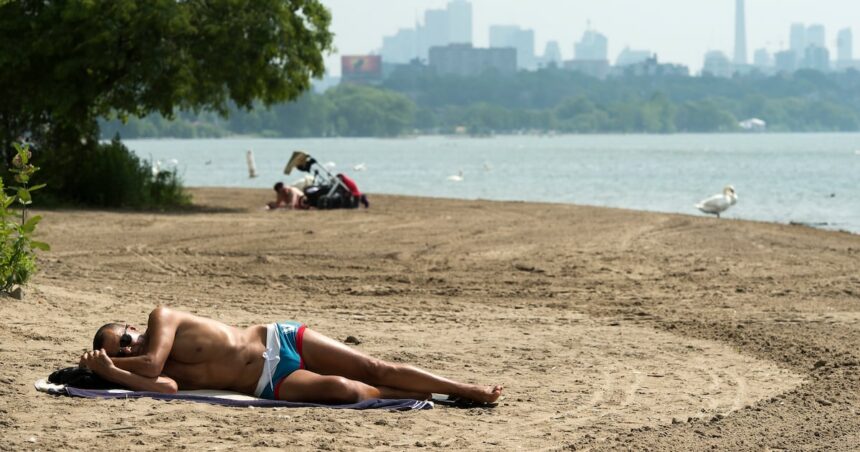As the summer sun beat down on Toronto’s concrete landscape yesterday, temperatures soared to 36.1°C, making it the hottest day the city has experienced in nearly a decade. Walking through Trinity Bellwoods Park, I watched as families sought refuge under maple trees, their children splashing in the water features that have become urban oases during this relentless heat wave.
“We haven’t seen temperatures this extreme since July 2016,” explained David Phillips, senior climatologist with Environment Canada, when I spoke with him by phone. “What makes this particularly concerning is the duration. We’re looking at seven consecutive days above 30 degrees, with humidity making it feel closer to 40.”
The scorching temperatures have transformed daily life across the city. Along Queen Street West, restaurants have extended patio misters to sidewalks where pedestrians pause momentarily for relief. TTC platforms have become underground saunas, with riders visibly wilting while waiting for the next train.
City officials responded by extending hours at 14 cooling centers across Toronto neighborhoods, particularly in areas with higher populations of seniors and vulnerable residents. Toronto Public Health reported a 30% increase in heat-related hospital visits compared to seasonal averages.
Toronto Hydro has urged residents to reduce electricity usage between 3 and 7 p.m., as the power grid strains under the weight of millions of air conditioners running simultaneously. Yesterday’s peak power demand reached 19,600 megawatts, approaching the provincial record set in 2006.
“This isn’t just uncomfortable – it’s dangerous for many Torontonians,” Dr. Eileen de Villa, Toronto’s Medical Officer of Health, told me during a brief interview at a downtown cooling center. “Particularly for elderly residents, those with chronic health conditions, and people experiencing homelessness.”
At Moss Park, outreach workers distributed water bottles and cooling towels to unhoused individuals. Street nurse Cathy Crowe described the situation as increasingly dire. “We’re seeing people with heat exhaustion, severe dehydration. The shelters are overcrowded and many lack adequate cooling systems.”
Climate researchers at the University of Toronto point to this heat wave as consistent with climate change projections for the region. Dr. Sarah Henderson from the School of Environment explained that Toronto can expect these extreme heat events to become more frequent and intense in coming years.
“What was once considered exceptional weather will increasingly become our summer norm,” she noted while reviewing temperature data in her campus office. “Urban heat island effects amplify temperatures by 3 to 5 degrees in downtown areas compared to surrounding regions.”
The financial impact extends beyond increased energy bills. The Ontario Federation of Agriculture estimates crop yields could decrease by up to 15% if the heat continues, potentially affecting food prices later this year. Small businesses along Kensington Market reported customer traffic down by nearly a third as shoppers avoid daytime outings.
For TTC worker Manuel Ramirez, the heat creates additional workplace challenges. “Some of the older subway stations don’t have proper ventilation systems. We’re providing extra breaks for employees and making sure everyone stays hydrated,” he explained while monitoring platform conditions at Queen station.
Toronto’s response has highlighted both resilience and inequality. While Riverdale and High Park neighborhoods have seen residents organizing community cooling stations and check-ins for vulnerable neighbors, residents of Thorncliffe Park have expressed frustration at limited public cooling options in their area.
The city’s infrastructure is being tested in ways that reveal long-standing vulnerabilities. Power outages have affected several neighborhoods, including a six-hour blackout in parts of Scarborough yesterday that left approximately 3,000 residents without air conditioning during peak afternoon heat.
Parents like Aisha Chaudhry from Don Mills are improvising to keep children safe and entertained. “The splash pads are packed, so we’ve been rotating between libraries, malls, and friends’ homes with pools,” she said while watching her children enjoy ice cream at Edwards Gardens.
This extended heat event has prompted renewed discussions about climate resilience at City Hall. Councillor Mike Layton has called for an expanded urban canopy program and requirements for cooling systems in all new residential developments.
“The evidence is clear that extreme heat is becoming our new reality,” Layton stated during yesterday’s emergency committee meeting. “We need to build a more resilient city that protects all residents, regardless of income or neighborhood.”
As Torontonians adapt to this new thermal reality, community organizations have stepped up their outreach. The Neighbourhood Group has mobilized volunteers to conduct wellness checks on seniors living alone, while faith communities have opened their air-conditioned spaces to anyone seeking refuge.
Environment Canada predicts relief will finally arrive this weekend, with temperatures expected to drop to seasonal norms by Sunday. Until then, the city continues to simmer under a heat dome that has tested infrastructure, strained resources, and reminded residents that climate adaptation is no longer a future concern, but a present necessity.






